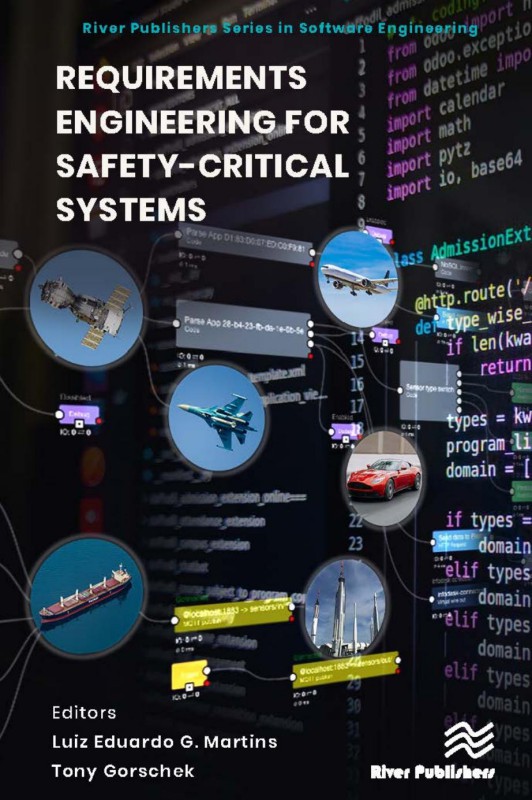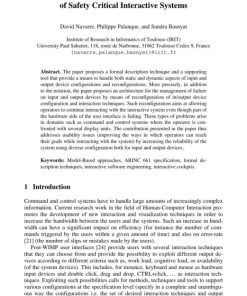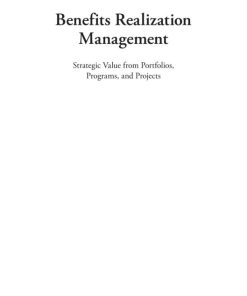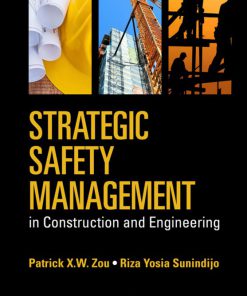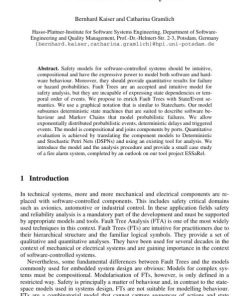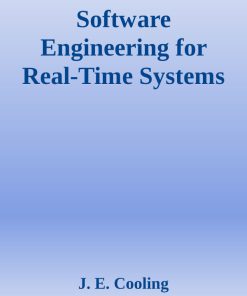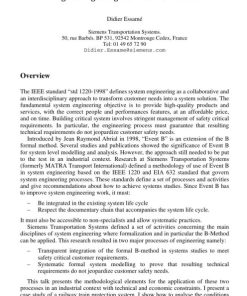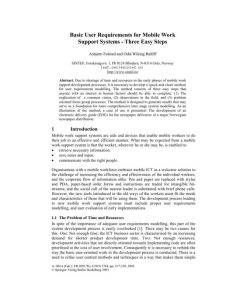Requirements Engineering for Safety Critical Systems 1st Edition by Luiz Eduardo G Martins ISBN 1000795969 9781000795967
$50.00 Original price was: $50.00.$25.00Current price is: $25.00.
Authors:Martins, Luiz Eduardo G.;Gorschek, Tony; , Series:IT & Computer [401] , Tags:Computer Communication Networks; Information Technology , Author sort:Martins, Luiz Eduardo G.;Gorschek, Tony; , Ids:9788770224277 , Languages:Languages:eng , Published:Published:Dec 2021 , Publisher:River Publishers , Comments:Comments:The “River Publishers Series in Software Engineering†is a series of comprehensive academic and professional books which focus on the theory and applications of Computer Science in general, and more specifically Programming Languages, Software Development and Software Engineering. Books published in the series include research monographs, edited volumes, handbooks and textbooks. The books provide professionals, researchers, educators, and advanced students in the field with an invaluable insight into the latest research and developments.
Requirements Engineering for Safety-Critical Systems 1st Edition by Luiz Eduardo G. Martins – Ebook PDF Instant Download/Delivery. 1000795969, 9781000795967
Full download Requirements Engineering for Safety-Critical Systems 1st Edition after payment
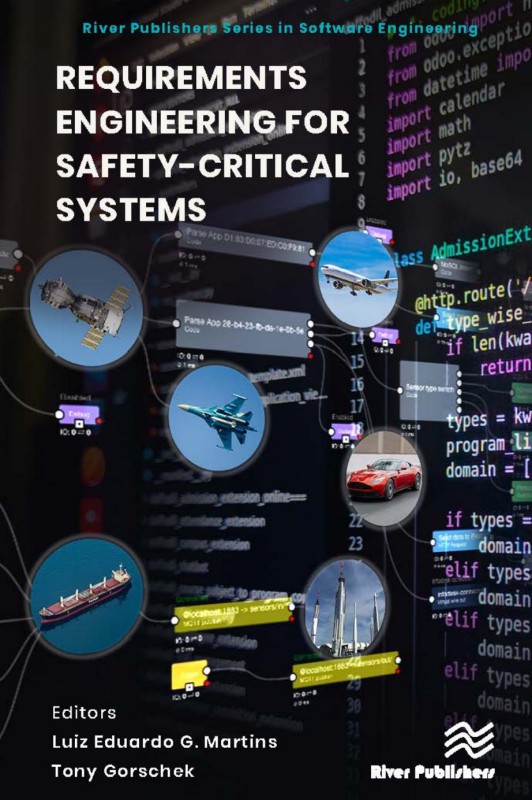
Product details:
ISBN 10: 1000795969
ISBN 13: 9781000795967
Author: Luiz Eduardo G. Martins
Safety-Critical Systems (SCS) are increasingly present in people’s daily activities. In the means of transport, in medical treatments, in industrial processes, in the control of air, land, maritime traffic, and many other situations, we use and depend on SCS. The requirements engineering of any system is crucial for the proper development of the same, and it becomes even more relevant for the development of SCS. Requirements Engineering is a discipline that focuses on the development of techniques, methods, processes, and tools that assist in the design of software and systems, covering the activities of elicitation, analysis, modeling and specification, validation, and management of requirements. The complete specification of system requirements establishes the basis for its architectural design. It offers a description of the functional and quality aspects that should guide the implementation and system evolution. In this book, we discuss essential elements of requirements engineering applied to SCS, such as the relationship between safety/hazard analysis and requirements specification, a balance between conservative and agile methodologies during SCS development, the role of requirements engineering in safety cases, and requirements engineering maturity model for SCS. This book provides relevant insights for professionals, students, and researchers interested in improving the quality of the SCS development process, making system requirements a solid foundation for improving the safety and security of future systems.
Requirements Engineering for Safety-Critical Systems 1st Table of contents:
1 Introduction
2 The Role of the Safety and Hazard Analysis
2.1 Introduction
2.2 Foundations of Safety Engineering
2.2.1 The Threats: Faults, Errors, and Failures
2.2.2 Safety Concepts
2.3 A Method for Safety and Hazard Analysis
2.3.1 Step 1: Hazards Identification
2.3.2 Fault-Tree Analysis (FTA)
2.3.3 HAZOP
2.3.4 STAMP/STPA
2.4 Step 2: Hazards Evaluation
2.4.1 Step 3: Risk Analysis
2.5 Safety-related Requirements Specification
2.5.1 The Means to Obtain Safety
2.5.2 Model-driven Approaches
2.5.3 Textual-driven Approaches
2.5.4 Model-driven Approaches Combined with Natural Language Specification
2.5.5 Ontological Approach to Elicit Safety Requirements
2.6 Conclusions
3 Integrating New and Traditional Approaches of Safety Analysis
3.1 Introduction
3.2 Background and Related Work
3.2.1 Background
3.2.2 Related Work
3.3 Traditional Approaches
3.3.1 FMEA: Failure Mode and Effect Analysis
3.3.2 FTA: Fault Tree Analysis
3.4 New Approaches
3.4.1 STAMP
3.4.2 STPA
3.5 Integration Between New and Traditional Approaches
3.6 Conclusion
4 Agile Requirements Engineering
4.1 Introduction
4.2 Agile Methods
4.2.1 Scrum
4.2.2 XP
4.3 Agile Requirements Engineering in SCS
4.3.1 Requirements Elicitation
4.3.2 Requirements Analysis & Negotiation
4.3.3 Requirements Specification
4.3.4 Requirements Validation
4.3.5 Requirements Management
4.4 Traditional x Agile Requirements Engineering
4.5 Case Studies
4.5.1 Pharmaceutical Company
4.5.2 Avionics Company
4.6 Conclusions
5 A Comparative Study of Requirements-Based Testing Approaches
5.1 Introduction
5.2 Background and Related Work
5.3 Experiment Design
5.4 Results and Discussion
5.5 Conclusions
5.6 Future Work
6 Requirements Engineering in Aircraft Systems, Hardware, Software, and Database Development
6.1 Introduction
6.2 Aviation Standards
6.2.1 SAE ARP 4754A
6.2.2 RTCA DO-297
6.2.3 RTCA DO-178C
6.2.4 RTCA DO-254
6.2.5 RTCA DO-200B
6.3 Requirements Engineering in Aviation
6.3.1 Certification Requirements
6.3.2 Aircraft and System Requirements
6.4 Software Requirements
6.4.1 Model-Based Software Requirements
6.4.2 Software Requirements Using Object-Oriented Technology
6.4.3 Software Requirements Using Formal Methods
6.5 Hardware Requirements
6.5.1 Onboard Database Requirements
6.5.2 Parameter Data Items
6.5.3 Aeronautical Databases
6.6 Conclusion
7 Generating Safety Requirements for Medical Equipment
7.1 Introduction
7.2 Related Works
7.3 Framework for Integration of Risk Management Process
7.3.1 Risk Management Process According to ISO 14971
7.3.2 Framework Description
7.3.2.1 Equipment Functions
7.3.2.2 Hazardous Situations Level 1
7.3.2.3 Equipment Architecture
7.3.2.4 Risk Evaluation and Control Level 1
7.3.2.5 Development of Components
7.3.2.6 Hazardous Situations Level 2 Evaluation and Risk Control
7.4 Conclusion
8 Meta-Requirements for Space Systems
8.1 Introduction
8.2 Requirements Engineering in Space Systems
8.2.1 Requirements in Space Systems
8.2.2 Meta-Requirements in Space Systems
8.2.3 Requirement Engineering Process in Space Systems
8.3 Meta-requirements Selected to Space Systems
8.3.1 Accuracy
8.3.2 Availability
8.3.3 Completeness
8.3.4 Consistency
8.3.5 Correctness
8.3.6 Efficiency
8.3.7 Failure Tolerance
8.3.8 Maintainability
8.3.9 Modularity
8.3.10 Portability
8.3.11 Reliability
8.3.12 Recoverability
8.3.13 Robustness
8.3.14 Safety
8.3.15 Security
8.3.16 Self-description
8.3.17 Simplicity
8.3.18 Stability
8.3.19 Survivability
8.3.20 Testability
8.3.21 Traceability
8.4 Conclusion
9 The Role of Requirements Engineering in Safety Cases
9.1 Introduction
9.2 Safety Cases
9.2.1 Definition
9.2.2 Example
9.2.3 Development
9.3 Requirements Artefacts and Safety Cases
9.3.1 Safety Requirements
9.3.2 Argumentation patterns
9.4 Safety Case Development and Requirements Processes
9.4.1 Joint development
9.4.2 Traceability
9.5 Conclusions
10 Safety and Security Requirements Working Together
10.1 Introduction
10.2 Approaching Safety and Security Requirements
10.2.1 Understanding the Stuxnet
10.2.2 May Stuxnet Similar Case Also Happen in Aircraft?
10.2.3 But are the authorities doing something in this new scenario?
10.2.4 Understanding the DO-326A/ED-202A Airworthiness Security Process Specification
10.2.5 Why Do We Need Specific Guidelines for Security Requirements?
10.2.6 A Practical Example of a Possible Back Door for an Attacker
10.2.7 Considering Security Aspects During the Aircraft Development Lifecycle
10.2.8 Defining Security Treat Conditions
10.2.9 Security Measures
10.2.10 Developing Security Requirements
10.3 Conclusion
11 Requirements Engineering Maturity Model for Safety-Critical Systems
11.1 Introduction
11.2 A Maturity Model for Safety-Critical Systems
11.2.1 Process Area View
11.2.2 Maturity Level View
11.3 Evaluating the safety processes
11.3.1 Assessment Instrument and Tool
11.3.2 Results of a Safety Maturity Assessment
11.4 Conclusions
People also search for Requirements Engineering for Safety-Critical Systems 1st:
requirements engineering for safety-critical systems
requirements engineering for safety critical systems
safety engineer requirements
safety critical systems
requirements engineering for software and systems
You may also like…
eBook PDF
Software Engineering for Real Time Systems 1st Edition by Jim Cooling ISBN 0201596202 9780201596205

